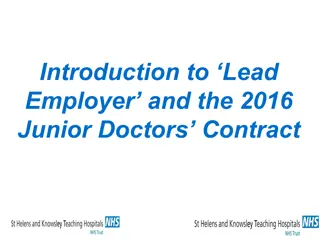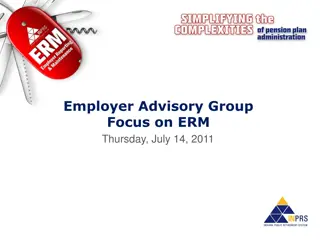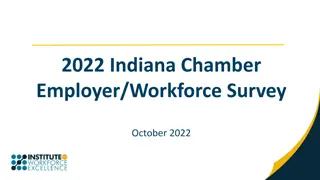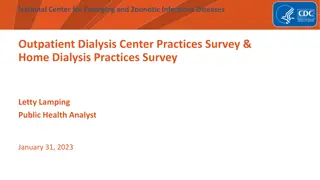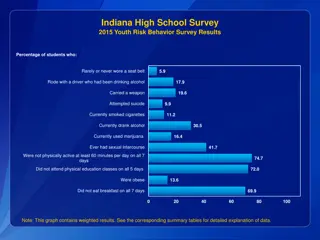Employer Skills Survey 2015 Overview in the UK
The Employer Skills Survey 2015 provides insights into skill shortages, retention challenges, utilization of skills, and training and development in establishments across England. The survey covers various regions and highlights areas with notable skills and employment challenges, showcasing variations by location and providing a detailed analysis of workforce trends.
Uploaded on Sep 25, 2024 | 0 Views
Download Presentation

Please find below an Image/Link to download the presentation.
The content on the website is provided AS IS for your information and personal use only. It may not be sold, licensed, or shared on other websites without obtaining consent from the author. Download presentation by click this link. If you encounter any issues during the download, it is possible that the publisher has removed the file from their server.
E N D
Presentation Transcript
Employer Skills Survey 2015 LEA/LEP Slide Pack May 2016
Contents Background 3 Employers experiences of skill shortages 8 Retention difficulties 12 The internal skills challenge 14 Under-utilisation of skills 23 Training and Workforce Development 28
Chapter 1: Background and Introduction 3
ESS 2015 overview ESS 2015 is the third time the survey has been run at UK-level 75,129 telephone interviews with establishments in England The 2015 survey covers establishments with 2 or more people working at them The 2011 survey included establishments with one employee these were not covered in 2013 or 2015. Where comparisons are made with 2011 or 2013 findings, these are based on re-weighted 2011 data (configured to represent the 2+ employment business population used in 2013 and 2015).
LEA / LEP -overview Owing to the scale of ESS 2015, it is possible to explore variation by locations using boththe LEA and LEPgroupings. The data in this slide pack provides an overview as to the sorts of analysis that can be conductedby LEA andLEP. The slide pack largely focuses on the LEAs and LEPs exhibiting very high and very low proportions for key measures. This is not with the intention to form judgements on different areas on England, but rather highlight where the pockets of skills and employment challenges areseen. It is clear there are wide variations by locality, even within the same broad region ofEngland. Accompanying LEA and LEP Excel tables show the full detail of theanalysis.
Achieved interviews / confidence intervals For a question asked of all respondents where the survey result is 50%, we are 95% confidentthat the true figure lies within the range 49.64% to50.36% Numberof interviews (Maximum) SamplingError Numberof interviews (Maximum) SamplingError Population Population England 1,488,201 75,129 +/-0.36 England 1,488,201 75,129 +/-0.36 LEA (High andLow) LEP (High andLow) London 260,280 10,629 +/-0.95 Essex 40,475 2,013 +/-2.18 Hampshire 39,075 1,773 +/-2.33 SouthEast 109,586 4,932 +/-1.40 Kent 40,472 1,722 +/-2.36 NorthEast 42,604 4,289 +/-1.50 Hertfordshire 34,539 1,717 +/-2.37 Leeds CityRegion 73,792 4,049 +/-1.54 Lancashire 31,057 1,540 +/-2.50 Derby, Derbyshire, Nottingham andNottinghamshire 51,646 3,127 +/-1.75 Halton 2,670 124 +/-8.80 OxfordshireLEP 21,352 975 +/-3.14 Knowsley 2,237 118 +/-9.02 Cornwall and the Isles of Scilly 18,654 963 +/-3.16 Slough 3,376 117 +/-9.06 Worcestershire 17,070 956 +/-3.17 BracknellForest 2,832 95 +/-10.05 Cumbria 18,347 914 +/-3.24 Rutland 1,239 73 +/-11.47 Buckinghamshire ThamesValley 17,993 654 +/-3.83 Population counts from IDBR March2014
Key definitions Proportions are based on the number of establishments, defined here as a single location of an organisation, where at least two peoplework. Establishment base Proportions are based on the total number of employees and working proprietorsacross establishments. Employment base Vacancies Skill-shortage vacancies Skills gaps Under-utilisation Proportion of establishments with at least one employee deemed by their employerto be not fully proficient in their role Proportion of establishments with at least one employee with skills and qualifications more advanced than required for their current jobrole Incidence Proportion of establishments reporting at least one skill- shortagevacancy Proportion of establishments reporting at least onevacancy The proportion of all staffwith skills and qualifications more advanced than required for their current jobrole Density The number of staffreported as not fully proficient as a proportion of allemployment Vacancies as aproportion of all employment Skill-shortage vacancies asa proportion of allvacancies
Chapter 2: Employers experiences of skill shortages 8
Incidence and density of skill-shortage vacancies by LEA LowLEAs HighLEAs SSVIncidence 3% 6% 5% 2% 5% 3% 1% 15% 8% 9% 18% Density of skill- shortage vacancies 50.1% 48.0% 45.3% 42.9% 42.3% 22.6% 8.2% 6.8% 6.2% 5.4% 5.3% Rutland Bedford Slough Wolverhampton Brighton and Hove Darwen Bury Manchester Blackburn with Bracknell Forest Knowsley England (75,129) (221) (303) (117) (316) (118) (630) (95) (176) (210) (73) Base: All establishments (asshown)
Incidence and density of skill-shortage vacancies by LEP HighLEPs LowLEPs SSVIncidence 5% 7% 5% 6% 4% 4% 6% 9% 5% 5% 7% Density of skill- shortage vacancies 37.4% 30.4% 29.6% 29.1% 28.9% 22.6% 18.2% 17.9% 15.9% 14.4% 14.0% Birmingham Tees Valley Wiltshire Black County South West Swindon and Enterprise M3 Manchester Greater Region Liverpool City Worcestershire West of England Greater and Solihull England Heart of the (75,129) (1,381) (2,224) (1,016) (1,353) (2,777) (2,449) (1,492) (956) (3,015) (1,560) Base: All establishments (asshown)
Impact of skill-shortage vacancies (LEP) Increase workload for other staff 93% Cornwall and Isles of Scilly 84% Have difficulties meeting customer services objectives 49% Lose business or orders to competitors 55% Sheffield CityRegion 43% Experience increased operating costs 43% 59% TeesValley Delay developing new products or services 40% 52% Coventry andWarwickshire Have difficulties meeting quality standards 35% 50% Thames ValleyBerkshire Have difficulties introducing new working practices 35% 50% Coventry andWarwickshire Outsource work 30% 44% Sheffield City Region Withdraw from offering certain products or services altogether 24% 40% Sheffield City Region Have difficulties introducing technological change 23% 37% Stoke-on-Trent andStaffordshire Anyimpact 94% Indicates where an impact is mostprevalent in a singleLEP Base : All establishments with hard-to-fill vacancies that are all as a result of skill shortages (5,495)
Chapter 3: Retention Difficulties 12
LEAs / LEPs with high and low incidence of retention High LEPs ( 10%) Coventry and Warwickshire Coast toCapital Worcestershire Leicester andLeicestershire TheMarches OxfordshireLEP South EastMidlands Thames ValleyBerkshire BlackCountry London Heart of the SouthWest Northamptonshire Buckinghamshire ThamesValley High LEAs ( 15%) Barking andDagenham Croydon Rutland Lewisham Sutton Hillingdon Doncaster Low LEAs ( 4%) Bury Luton Warrington Stoke-on-Trent NorthSomerset CheshireEast Newham Oldham Isle ofWight Medway Sefton Gateshead Rochdale Wigan Low LEPs ( 6%) Cumbria Hertfordshire Lancashire Humber Greater Manchester Cheshire andWarrington West ofEngland Base: All establishments in Module 2 (asshown)
Chapter 3: The internal Skills Challenge 14
Density of skills gaps by LEA HighLEAs LowLEAs Skills gaps density 10.9% 9.3% 8.9% 8.6% 8.4% 5.1% 2.5% 2.4% 2.3% 2.2% 2.2% Hertfordshire Slough Cumbria Coventry Redcar and Cleveland Bexley Havering Bracknell Forest City of London Waltham Forest England (75,129) (1,717) (346) (252) (117) (914) (193) (256) (228) (95) (510) Base: All establishments (asshown)
Density of skills gaps by LEP HighLEPs LowLEPs Skills gaps density 10.9% 8.4% 6.4% 6.3% 6.1% 5.1% 3.8% 3.8% 3.5% 3.5% 3.2% Thames Valley Hertfordshire Cumbria Warwickshire Northamptonshire Berkshire Coventry and Gt Peterborough City Region West of England Gt Cambridge & New Anglia Dorset England Liverpool (75,129) (1,717) (914) (1,287) (1,019) (1,163) (1,186) (2,153) (1,492) (2,364) (1,560) Base: All establishments (asshown)
Main causes of skills gaps (LEA) Staff are new to the role 88%Slough 59% Their training is currently only partially completed 93%Rochdale 56% Staff lack motivation 68%Hertfordshire 34% They have had training but their performance has not improved sufficiently The introduction of new working practices 62%Bedford 29% 56%Coventry 29% 64%Lewisham Staff have not received the appropriate training 26% Unable to recruit staff with the required skills 66%Slough 25% The introduction of new technology 56%Hillingdon 20% The development of new products and services 55% Blackburn withDarwen 19% Problems retaining staff 47% Southend onSea 18% New to the role/ training not complete (transient) 72% Transient skill gaps only 20% Indicates where an impact is mostprevalent in a singleLEA Base : All establishments with skills gaps - up to 2 occupations followed up (15,409) Figures are shown as a percentage of all gaps (not a percentage of allestablishments)
Main causes of skills gaps (LEP) Staff are new to the role 59% 76% Cheshire andWarrington Their training is currently only partially completed 76% Gloucestershire 56% Staff lack motivation 68%Hertfordshire 34% They have had training but their performance has not improved sufficiently The introduction of new working practices 29% 42% Coast toCapital 43% York and NorthYorkshire 29% Staff have not received the appropriate training 35%Cumbria 26% Unable to recruit staff with the required skills 25% 44% Thames ValleyBerkshire The introduction of new technology 20% 47% Coventry andWarwickshire The development of new products and services 19% 26%London Problems retaining staff 28% Coast toCapital 18% New to the role/ training not complete (transient) 72% Transient skill gaps only 20% Indicates where an impact is mostprevalent in a singleLEP Base : All establishments with skills gaps - up to 2 occupations followed up (15,409) Figures are shown as a percentage of all gaps (not a percentage of allestablishments)
Impact of skills gaps (LEA) Increased workload for other staff 80%Haringey 52% Have higher operating costs 49%Redbridge 26% Have difficulties meeting quality standards 54%Haringey 25% Have difficulties introducing new working practices 60%Haringey 24% Lose business or order to competitors 51%Redbridge 21% Delay developing new products or services 49%Redbridge 17% Outsource work 11% No impact 70%Bournemouth 40% Indicates where an impact is mostprevalent in a singleLEA Base: All establishments with skills gaps(15,409)
Impact of skills gaps (LEP) Increased workload for other staff 62% Thames ValleyBerkshire 52% Have higher operating costs 20% NewAnglia 26% Have difficulties meeting quality standards 33% Thames ValleyBerkshire 25% Have difficulties introducing new working practices 33% Coventry andWarwickshire 24% Lose business or order to competitors 47%London 21% Delay developing new products or services 23%London 17% Outsource work 15% Thames ValleyBerkshire 11% No impact 53% Greater Manchester 40% Indicates where an impact is mostprevalent in a singleLEP Base: All establishments with skills gaps(15,409)
Action taken to overcome skills gaps (LEA) Increase training activity / spend or increase / expand trainee programmes 80% Brighton andHove 68% More supervision of staff 56% More staff appraisals / performance reviews 8%Havering 46% Implementation of mentoring / buddying scheme 73%Slough 45% Reallocating work 52% Hammersmith andFulham 33% Changing work practices 52%Wandsworth 27% Increase recruitment activity / spend 40%Wolverhampton 20% Recruiting workers who are non-UK nationals 36%Lambeth 10% Nothing 40% WalthamForest 15% Indicates where an impact is mostprevalent in a singleLEA Base: All establishments with skills gaps(15,409)
Action taken to overcome skills gaps (LEP) Increase training activity / spend or increase / expand trainee programmes 76% Northamptonshire 68% More supervision of staff 65%London 56% More staff appraisals / performance reviews 57% BlackCountry 46% Implementation of mentoring / buddying scheme 58% West ofEngland 45% Reallocating work 42% Thames ValleyBerkshire 33% Changing work practices 34% Thames ValleyBerkshire 27% Increase recruitment activity / spend 29% Buckinghamshire ThamesValley 20% Recruiting workers who are non-UK nationals 19%London 10% Nothing 25%Cumbria 15% Indicates where an impact is mostprevalent in a singleLEP Base: All establishments with skills gaps(15,409)
Section 4: Under-utilisation 23
Density of under-utilisation by LEA HighLEAs LowLEAs Skills under-utilisation density 15.5% 15.4% 11.9% 11.8% 11.7% 7.0% 4.6% 4.4% 4.3% 4.1% 3.4% Salford Lambeth Rutland Middlesbrough Redcar and Cleveland Dudley Wigan Oldham St Helens Knowsley England (75,129) (261) (73) (252) (313) (250) (118) (412) (202) (304) (167) Base: All establishments (asshown)
Density of under-utilisation by LEP HighLEPs LowLEPs Skills under-utilisation density 10.4% 8.9% 8.3% 8.2% 8.2% 7.0% 5.7% 5.7% 5.6% 5.2% 4.8% Tees Valley London Coast to Capital Humber The Marches Lancashire Warrington Gt Peterborough Cheshire and New Anglia Wiltshire England Swindon and Gt Cambridge & (1,016) (75,129) (1,353) (2,282) (1,354) (10,629) (1,239) (1,876) (2,153) (1,334) (2,364) Base: All establishments (asshown)
Reasons for under-utilisation (LEA) They are not interested in taking on higher level role 53%Halton 26% Working hours suit thembetter 15% 39% Southend onSea Lack of jobs in desired higher level role 10% 26%Bolton To gain experience / current role is lower level in same industry as desired higher level role 10% 32%Slough They own the business / are a partner in the business 9% 29%Harrow Attractive conditions of employment 7% Temporary role / stopgap 19% Hammersmith andFulham 7% Actively seek staff with quals / skills beyondneeds 4% 14%Luton Family-run business 4% 17%Oldham Competition for higher level roles / struggling to get higher level job 4% 21% Isle ofWight Qualifications / skills not relevant to job role 3% 13%Solihull They have more than one job 1% 12%Greenwich Not particular reason / it just happened 10% 53%Halton Indicates where an impact ismost prevalent in a single LEA Base: All establishments with under-utilised staff(22,879)
Reasons for under-utilisation (LEP) They are not interested in taking on higher level role 41% NewAnglia 26% Working hours suit thembetter 15% 27% Buckinghamshire ThamesValley Lack of jobs in desired higher level role 10% 20% Cornwall and Isles of Scilly To gain experience / current role is lower level in same industry as desired higher level role 10% 13% Thames ValleyBerkshire They own the business / are a partner in the business 9% Attractive conditions of employment 7% Temporary role / stopgap 20% West ofEngland 7% Actively seek staff with quals / skills beyondneeds 4% Family-run business 10% Buckinghamshire ThamesValley 4% Competition for higher level roles / struggling to get higher level job 4% Qualifications / skills not relevant to job role 3% 6% Worcestershire They have more than one job 1% Not particular reason / it just happened 10% 17% BlackCountry Indicates where an impact ismost prevalent in a single LEP Base: All establishments with under-utilised staff(22,879)
Section 5: Training and Workforce Development 28
Proportion of employers training over the previous 12 months by LEA High LEAs LowLEAs 86% 81% 79% 79% 78% 66% 56% 56% 55% 52% 51% Halton Bexley England Reading Brent Rutland Barking and Haringey Plymouth Tower Hamlets Waltham Forest Dagenham (193) (75,129) (124) (271) (73) (196) (315) (228) (246) (147) (135) Base: All establishments (asshown)
Proportion of employers training over the previous 12 months by LEP High LEPs LowLEPs 72% 71% 71% 70% 70% 66% 65% 64% 64% 64% 64% Thames Valley Solent The Marches England Cumbria Liverpool City Tees Valley Gloucestershire Heart of the South (2,777) Leeds City Region West of England Berkshire Region West (1,492) (75,129) (1,982) (1,560) (1,353) (1,019) (991) (914) (4,049) (1,239) Base: All establishments (asshown)
Training Equilibrium: employers interest in providing more training than they were able to 66% of all employers train 34% don t train Amongthose who train Amongthose who don ttrain (Base:57,422) (Base:17,007) 30% 70% 52% 2% 46% Wanted totrain No trainingneed Wanted to trainmore Do sufficienttraining Don tknow 58% of employers in training equilibrium (no desire to increasetraining) 42% of employers want to train more Base: All establishments(75,129) *Note training employers responding Don t know have been included in the group Wanted to undertake more training on finalmeasure
Training Equilibrium: LEAs most likely to want to undertake more training (No desire for moretraining) 60% Wanted to undertake more training 40% Haringey (147) In training equilibrium 56% Wanted to undertake more training 44% Wolverhampton (316) In training equilibrium 55% Wanted to undertake more training 45% Lambeth (313) In training equilibrium 53% Wanted to undertake more training Southwark (444) 47% In training equilibrium 53% 47% Hounslow (272) Wanted to undertake more training In training equilibrium (Base: All establishments, asshown)
Training Equilibrium: LEPs most likely to want to undertake more training (No desire for moretraining) 47% Wanted to undertake more training 53% BlackCountry (1,381) In training equilibrium 47% Wanted to undertake more training 53% London (10,629) In training equilibrium Derby, Derbyshire, Nottingham and Nottinghamshire (313) 45% Wanted to undertake more training 55% In training equilibrium 45% Wanted to undertake more training TeesValley (1,353) 55% In training equilibrium 44% 56% Liverpool City Region (1,492) Wanted to undertake more training In training equilibrium (Base: All establishments, asshown)
Number and proportion of staff trained by LEA Total no. of stafftrained: 14.8m 43k 81k 37k 43k 81k 41k 38k 44k 42k 70k HighLEAs LowLEAs Proportion of staff trained 79% 78% 77% 77% 76% 63% 51% 51% 51% 48% 48% Torbay Southampton Liverpool Blackpool Plymouth Hackney Merton Kirklees West Berkshire Herefordshire England (75,129) (495) (160) (271) (176) (230) (406) (237) (252) (292) (475) Base: All establishments (asshown)
Number and proportion of staff trained by LEP Total no. of stafftrained: 14.8m 161k 407k 309k 473k 371k 131k 158k 503k 255k 171k HighLEPs LowLEPs Proportion of staff trained 72% 71% 71% 68% 68% 63% 57% 57% 56% 56% 54% Heart of the South West Region Hertfordshire Liverpool City Warringotn Cumbria Cheshire and Thames Valley The Marches Berkshire Northamptonshire Derby etc. Worcestershire England (75,129) (914) (1,492) (1,334) (2,777) (1,717) (956) (1,239) (3,127) (1,019) (1,163) Base: All establishments (asshown)
Training days provided by LEA HighLEAs LowLEAs Days peremployee Days per trainee 20.3 17.9 12.0 11.4 9.9 9.6 8.5 7.6 6.8 6.7 6.3 4.9 4.7 4.6 4.5 4.2 4.2 2.6 2.6 2.6 2.6 2.3 Derby Darwen Wrekin Sefton Liverpool Telford and Blackburn with Lambeth Wokingham Calderdale Nottingham England Hounslow (57,422) (176) (329) (215) (495) (287) (272) (427) (337) (173) (313) Base: All establishments (asshown) Note: Days per employee shown as an average for all employment across all establishments; days per trainee shown as an average of alltrainees
Training days provided by LEP HighLEPs LowLEPs 9.0 Days per employee Days per trainee 8.0 7.9 7.6 7.6 6.8 6.5 6.5 6.3 6.0 5.8 5.7 5.5 5.2 5.1 5.1 4.2 3.8 3.7 3.7 3.5 3.2 Heart of the South West Lancashire Region Liverpool City Worcestershire Cumbria Midlands Black Country Northamptonshire Berkshire Region England Sheffield City Thames Valley South East (57,422) (1,180) (650) (2,106) (736) (1,436) (1,848) (1,055) (1,887) (901) (830) Base: All establishments (asshown) Note: Days per employee shown as an average for all employment across all establishments; days per trainee shown as an average of alltrainees
For more information contact UKCES Employer Surveys 0207 227 7800 Employer.surveys@ukces.org.uk @ukces






